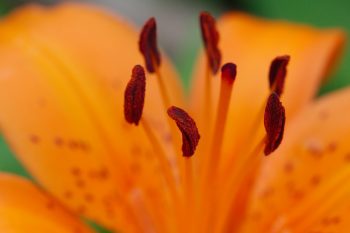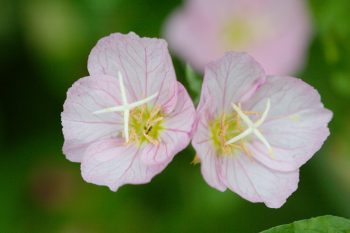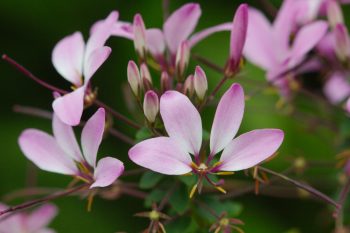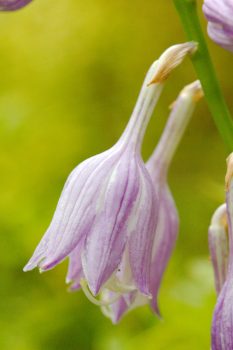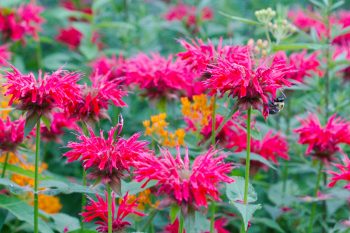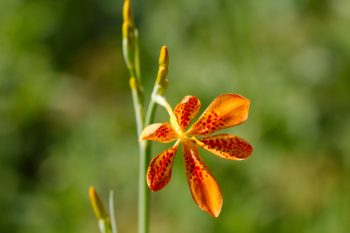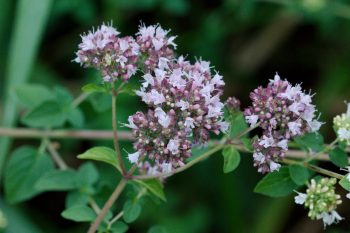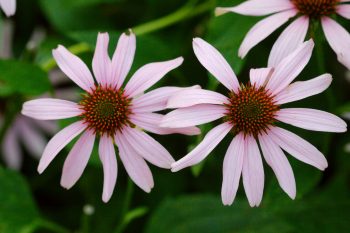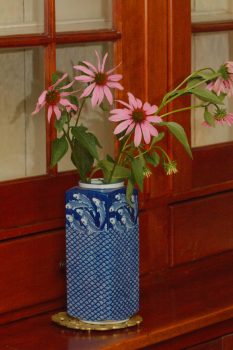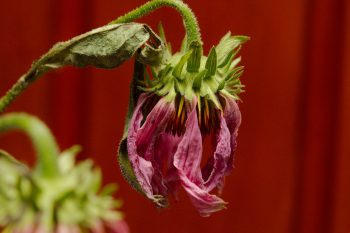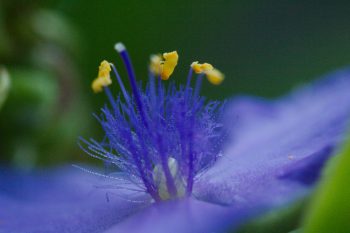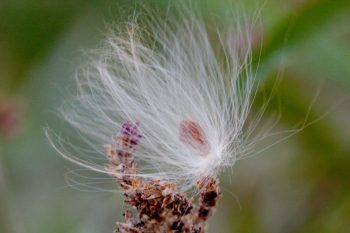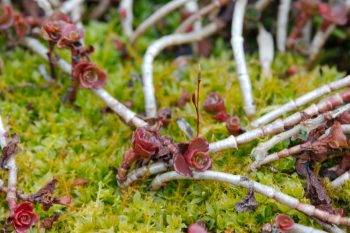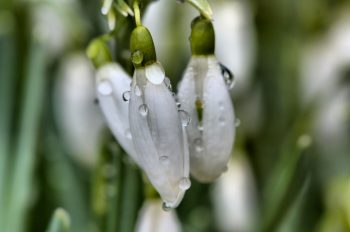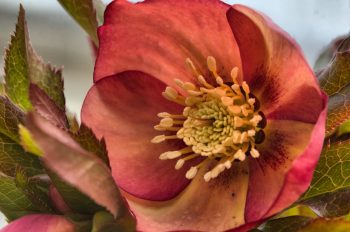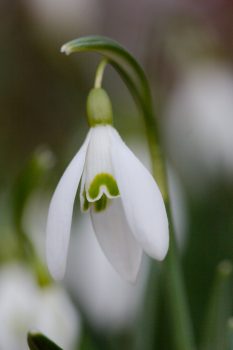The Asiatic lilies are in bloom around the yard. This one is in a container on the back patio but there are a bunch in the front garden, as well. We worry about them being eaten by rabbits or deer but this time of year, fortunately, there is a lot for them to eat and that means less chance of them finding these. We have a lot of rabbits this year. I’ve seen as many as four at once in our front or back yard. The seem to mostly be eating clover, though, and we have plenty of that to go around.
Tagged With: Perennial
Asiatic Lily
Oenothera speciosa (Pink Evening Primrose)
The evening primroses (Oenothera speciosa) are in bloom and they are quite lovely. They have spread through the garden but I wouldn’t call them an aggressive species, we don’t mind. We can easily pull them up if they show up where they aren’t wanted and generally, our garden isn’t so well organized that it matters. They are native to the southern half of the contiguous United States. They make a nice addition to any garden, blooming in the evening, their airy, pink blossoms particularly lovely in the dusk.
Cleome ‘Señorita Rosalita’
Commonly known as spider flower Cleome is a fast-growing, tender perennial grown here as an annual (it’s only hardy in USDA zones 9 and 10). This variety, ‘Señorita Rosalita’, is “noted for having no thorns, no unpleasant aroma, no sticky foliage, no seedpods and better disease resistance” (Missouri Botanical Garden Plant Finder). We love it and it’s been a regular feature in a container on out back patio. We really should plant more of them, as they always perform very well and bloom basically all summer from mid-June well into October or November.
Astilbe and Dryopteris
In the shade garden at the north end of our yard, we have a few different ferns. This is the most prevalent and it is some sort of Dryopteris but I don’t remember which. Dryopteris species have various common names including wood, shield, and male fern. In with this is an ostrich fern (Matteuccia struthiopteris) and a Japanese painted fern (Athyrium niponicum) as well as a small patch of sensitive fern (Onoclea sensibilis) that was already here when we bought the house. There are two or three Astilbe plants scattered throughout and they compliment each other pretty well, although a slightly taller Astilbe might be a good idea, as these are almost covered by the fern. As a bonus, I got a bee of some sort on the Astilbe flowers, which I didn’t notice when I was taking the picture.
Hosta La Vista, Baby
The genus Hosta has about 70 species native to Japan, Korea, China and eastern Russia. They are shade loving perennials grown mostly for their foliage but they have nice, if somewhat understated flowers, as well. The name Hosta is in honor of of Austrian botanist Nicholas Thomas Host (1761-1834). My parents had these in their garden and growing up I knew it as Funkia. That’s because the genus was renamed to that in 1817 “in honor of botanist Heinrich Christian Funk under the belief at that time that Hosta was an invalid name.” Early in the 20th century the name was switched back but the plants are still referred to as Funkia by some (including my parents, evidently).
This one is growing in a container just outside our front door. There are generally two pests that eat Hosta plants. Slugs can do significant damage to them, eating holes in the leaves. In our garden, that’s generally not so destructive that we worry about it, although it can make the leaves a little less attractive. The other culprit is deer, who really seem to love Hosta leaves. Although we see deer in our yard and often see signs of their presence, they don’t seem to come too close to the house. So, we keep the Hostas close and that seems to be enough. We also put up deer repellent although I don’t actually know how much help that is. It certainly doesn’t do any harm.
Monarda, Asclepias, and a Bombus
Along our back fence, the garden has really gotten out of control. With the work we’ve been doing on our mom’s houses, we haven’t really had time to give it half the attention it needs and deserves. Consequently, it’s got goldenrod, poke weed, and thistles growing in abundance. Three of our planted perennials are doing quite well, however, including the bee balm (Monarda didyma, also known as Oswego tea or bergamot) and the butterfly weed (Asclepias tuberosa) shown here. The other, not yet in bloom, is obedient plant (Physostegia virginiana). All three are native to the area and extremely tough. The bees love them and I followed this common eastern bumble bee (Bombus impatiens) for a while as he moved from flower to flower.
Iris domestica
This is Iris domestica, often called blackberry lily or leopard lily and formerly known as Belamcanda chinensis. It’s a perennial plant that we have in various places in our garden. We gather the seeds most years and spread them in areas we would like it to grow, although I don’t know if we’re doing as well as the birds when it comes to actually spreading it. As you can see, it has vaguely lily-like flowers and they are quite lovely. They each last a day but they are born in clusters, blooming one after the next for quite a while. In case you were wondering, the genus name Iris comes from the Greek goddess of the rainbow.
Oregano Flowers
I have a little plot with a fence around it where I grew a few vegetables when it was first put in. Summers have been quite busy and keeping up with vegetables has been tough. Also, it’s small enough that it really isn’t worth the trouble. So, I’ve planted a few herbs and don’t have to get out there nearly as often. Temperatures down to 0°F this last winter took care of the rosemary but the oregano (Origanum vulgare, a member of the mint family native to Europe through central Asia) is going strong. In fact, it’s practically taken over the entire plot.
Purple Coneflower
It’s been a good year for the purple coneflower (Echinacea purpurea) in our yard. Of course, it’s been an even better year for the weeds. With most weekends at least partly devoted to dealing with one or both of our mom’s houses, we’ve spent a lot less time in the garden this year. There is bindweed (Convolvulus species) everywhere and it’s running riot. In particular, along the back fence and the garden along the south end of the house are both totally out of control. There is significant pokeweed, goldenrod, various thistles, and even a few trees (zelkova, elm, maple, and ash). But there are some blooms that were intended, as well, including this coneflower.
Purple Coneflowers
Cathy brought some coneflowers in this evening to put in a vase in or dining room. Actually, they got knocked over when she was cutting the grass so she figured we might as well enjoy them as they die. I think they look really nice against the rich brown of this china cabinet. As you might be able to tell, the china cabinet is empty. We’ll put things in it but we haven’t gotten around to it yet. For now, the things that could go in it are in boxes and taking up space that could be used in better ways. But finding them and figuring out what we want where is a bit too much for us right now.
We don’t bring flowers in very often but I’m always glad when we do. One of the nicest photos I’ve taken, actually, is a vase of flowers, mostly roses, that Cathy arranged. It was sitting on our kitchen table and the late afternoon sun was coming in and lighting it from the side so the background went fairly dark and the flowers glowed nicely. I’ve made a few prints of that one, taken in 2010, and it’s been fairly popular. I don’t think this one will win any awards but I do like the colors and it’s a relaxing picture, to me.
Wilting Coneflower
Ten days ago I posted a picture of purple coneflowers in a blue and white vase against the dark cherry of a china cabinet. I was a little surprised by the relatively warm reception it received. Those same flowers are now a little bit past their prime. This is one of them, drooping and a little faded, but still quite lovely in its own way. Of course, we all want to be the strong, beautiful flower, blooming where we are planted. But that’s fleeting, as it is written, “As for man, his days are like grass; he flourishes like a flower of the field; for the wind passes over it, and it is gone, and its place knows it no more.” (Psalm 103:15-16 ESV) But even his days are not all full bloom. We start as a small sprout (metaphorically speaking), grow, (hopefully) bloom, and (even more hopefully) bear fruit. But then we grow old and begin to fade, like this flower. That, too, can be beautiful. Lord, help me to grow old gracefully.
Black-eyed Susan
I took some pictures of skippers on black-eyed Susan flowers this evening. I also got a few decent shots of a little leaf hopper, which I haven’t identified. They are quite small and this one was probably only about 5mm long. There are about 3,000 described species in north America along and it is estimated that there are more than 100,000 species worldwide, with less than a quarter actually having been described. I decided to post this picture, instead of one with an insect, just because I like the shallow depth of field on the yellow petals of the black-eyed Susan.
Tradescantia virginiana (Spiderwort)
This spiderwort (Tradescantia virginiana) is growing right outside our kitchen door and although it doesn’t have so many flowers at this time of the year, it still manages to put out a few. They are such beautiful little flowers and I can’t imagine not having them in our garden. The color ranges from blue to purple and it’s not always the same in photographs as it is to the eye. It’s possible that some of the color comes from the physical structure of the flower rather than from a pigment but I don’t actually know for sure. Examples of structural colors include those found in peacock feathers, butterfly wings, and the beautiful iridescence of beetle carapaces. If you are interested in structural colors, you might find this article interesting: Color from Structure in The Scientist.
Milkweed Seed
It turned cold over the last few days. Not bitter, winter cold, but relatively cold with lows down in the mid 30s. This morning it was below freezing for the first time this fall and the forecast is for more of the same. In the sus this afternoon it was pleasant enough if you’re like me and prefer cool weather to hot. The insects are starting to be less in evidence and Cathy was actually looking for dead insects in the yard to send to a friend (it’s probably just about as weird as it sounds). She found a carpenter bee and I took pictures of it before making sure it was dead with a little chloroform in a jar. I also took pictures of holly berries on the tree at the corner of our house. Then I spotted this milk weed seed on the top of a drying Verbena bonariensis stem and decided that’s what I’d use for today’s photo.
Sedum and Moss
In a small pot outside our front door is a tiny little sedum with moss growing around it. This is a surprisingly hardy little plant, being able to take single digit (Fahrenheit) temperatures in an above ground container without any significant problems. We aren’t sure which sedum it is, but Cathy’s guess was that it’s “Red dragon” which seems quite reasonable. The moss in this photo, with its two calyptrae (the spore bearing capsules), is a volunteer, but mosses are generally welcome here. The only places the grow that I would prefer they didn’t is between the shingles on the roof of our garage. I like them otherwise and would happily have a garden devoted to them, if I had the time and space.
Ornamental Grass
After church today we had a nice lunch with some friends. It’s good to have friends and these are among the best. It was a nice day so when we left them, we decided to to to Lake Frank and take a walk. We started at the south end of the lake and walked across the dam. From there we went through the woods on the Parilla Path to the Gude Trail, which we walked to where it hits a parking lot on Gude Drive. The round trip was a little short of three miles and it was quite pleasant. Walking west (outbound) we had the sun in our eyes, so the return journey was nicer, I think. But these tassels on some ornamental grass were nice, backlit by the afternoon sun.
Black-eyed Susan
It was a pretty normal, overcast, somewhat dreary, winter’s day today. No rain or snow but cool and damp. The ground is completely saturated and there is some leftover snow scattered around. It’s warmer than it’s been and forecast to be in the 60s this week. This is the remains of a black-eyed Susan (Rudbeckia species). We leave them through the winter for the birds, although most of them don’t get eaten by the spring. Sometimes we’ll see goldfinches (Spinus tristis) or dark-eyed juncos (Junco hyemalis up in them, but food is never really scarce around here.
Snow Drops
The snow drops (Galanthus nivalis) along the edge of the woods near my office have been in bloom for a week or more. Those in our yard are in a more sheltered spot and tend to bloom later but they are coming out now. Early this afternoon I decided to take some pictures of them with snow all around them. I got a few like that but decided I like this close up better, even though it doesn’t show the snow. They’re not really open in this picture but they open up on warm days before closing up at night. With yesterday’s snowfall, they have gone back into winter mode but it won’t be long before they are open for good. The daffodils are also coming up and showing signs of buds in amongst the leaves. It’s still winter here, but spring is coming.
Lenten Rose ‘Mango Magic’
It’s Lenten rose time again. With the recent snow and heavy rain, they are looking decidedly unhappy, but the blooms are coming and should soon be out in full. This one, a Helleborus called ‘Mango Magic’, it the furthest along of those in the yard. There is a very large one with deep burgundy flowers that’s doing well, also and probably needs to be divided up into three or four plants. I do love the deep color of that one but the brightness of this one and a few others we have are quite nice, as well.
Snow Drops (Galanthus nivalis)
I know I posted a picture of snow drops (Galanthus nivalis) on Saturday, March 02, 2019 but the flowers were not really open then and they are now. Our yard is fairly shady and the spring blooms seem to be a week or so behind those that get full sun. We have a few clmps of snow drops in the yard. Those I photographed last time are by the sidewalk. These are in the back yard. They are certainly a welcome sign of spring, often blooming when there is still snow on the ground (thus the name, I assume). I love the little touch of green on the central part of the flower. Green is fairly uncommon as a flower color, I assume because it’s so common on the leaves themselves. But it makes a nice change.
The snow drops are generally followed by the winter aconite (Eranthis hyemalis) and the Lenten rose (Helleborus species). One Lenten rose is already blooming but the others are just starting to come out. I suspect I’ll have more pictures of them soon.

